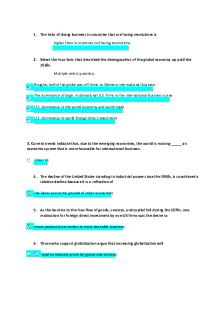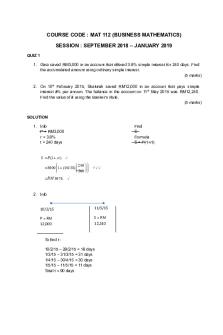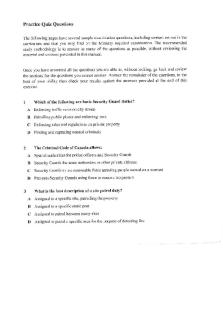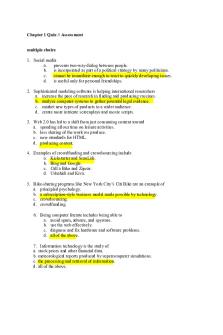Practice Quiz 1 PDF

| Title | Practice Quiz 1 |
|---|---|
| Author | Ten Lyu |
| Course | Intermediate Macroeconomics |
| Institution | University of Nebraska-Lincoln |
| Pages | 11 |
| File Size | 177 KB |
| File Type | |
| Total Downloads | 79 |
| Total Views | 171 |
Summary
Practice Quiz 1...
Description
Practice Quiz 1 ECON 311 Use the following US data to answer questions (1)-(6). Note that GDP is in billions of US dollars, while Population is in millions. Year
GDP
Deflator
Population
1960 1961 1962
$542 $562 $604
99 100 101
181 184 187
1)
Calculate Real GDP for each year in the table.
2)
What is the unit for Real GDP calculated in the previous question?
3)
What is the growth rate of Real GDP between 1961 and 1962? What is the growth rate of the Population?
4)
Using the numbers in the previous problem, what was the approximate growth rate of Real GDP per Capita between 1961 and 1962?
5)
Suppose that Real GDP per Capita continued to grow at the same rate in the previous problem. What would Real GDP per Capita be in 2018?
6)
What is the value of the previous problem in 2018 Dollars if the value of the Deflator is 650 in 2018?
7)
Which price index measures all consumption prices? (a) Consumer Price Index (b) Producer Price Index (c) Personal Consumption Expenditure Index (d) GDP Implicit Price Deflator
8)
According to the Circular Flow Diagram, if the US has a trade deficit then (a) other countries must be investing in the US. (b) the US must be loaning funds to other countries. (c) the US will grow more slowly. (d) A country must have balanced trade in the Circular Flow Diagram.
9)
Household income is split between (a) savings, consumption, and taxes. (c) wages and consumption.
(b) consumption and savings. (d) wages and taxes.
10)
Over the past few decades, the consumption share of GDP has consumption share of GDP has . (a)risen; risen (b) fallen; fallen (c) risen; fallen (d) fallen; risen
11)
Which component of GDP is the primary driver of business cycles? (a) Consumption (b) Investment (c) Government Spending (d) Exports
1
while the government
The table below describes the prices and quantities in an economy with three goods: cars, fuel (gallons), and cell phones. Use the table to answer questions (12)-().
Good
Quantities 2015 2016
Cars Phones Fuel
5 200 1,700
6 220 2,000
Prices 2015 $25,000.00 $600.00 $3.50
2016
$28,000.00 $600.00 $3.25
12)
What is the value of Real GDP in 2016 if the base year is 2015?
13)
Calculate the individual price index for each good using 2016 as the base year. What are the values of the price index for each good in 2015?
14)
Calculate the expenditure weights for each good in the aggregate price index using 2016 as the base year.
15)
What is the value of the aggregate price index in 2015? (using 2016 as the base year)
16)
What is the inflation rate between 2015 and 2016?
Use the table below to answer questions (17)-(18). Assume that the economy consists on only two firms: a local farm & a local grocery store. The farm provides the grocery store with all of the vegetables & meat that it sells.
Revenue Wages Int. Goods Profits
Farm
Grocery Store
$2,000 $1,000 $0 $1,000
$2,750 $500 $2,000 $250
17)
What is the value added by the grocery store?
18)
What is GDP in the economy using the income approach?
19)
Which of the following price indices is preferred by the Federal Reserve to measure inflation? (a) GDP Deflator (b) CPI (c) PCEI (d) Chained Index
20)
If the nominal GDP rises by 6% and the real GDP rises by 4%, then the price level rises by how much?
21)
Which of the following would not be included in Government Consumption & Investment (G)? (a) A local government increases education funding by $2 million. (b) The US government gives a tax refund to all citizens. (c) The state of Nebraska builds a new road. (d) The US government contracts a US firm to build a variety of airplanes. 2
Use the table below to answer questions (22)-(23). Assume that an economy consists of only three firms: a farm, a tortilla factory, and a restaurant. The farm supplies corn to local residents and to the other two firms. The factory supplies tortillas only to the restaurant. The restaurant uses the corn and tortillas to produce delicious food for consumers.
Revenue Wages Intermediate Goods Corn Tortillas Profits
Farm
Tortilla Factory
Restaurant
$1,000 $500
$2,000 $500
$4,000 $1,000
$500
$500 $1,000
$250 $2,000 $750
22)
How much corn did the farm produce as a final good?
23)
What is GDP in the economy using the value-added approach?
24)
Nominal GDP means that the value of all goods and services is measured in (a) average (b) last year’s (c) the base year’s (d) current (e) constant
prices.
The table below describes the National Income and Product Accounts in the US for 2015. Use the table to answer questions (25)-(27). Government Consumption & Investment $3,219 Federal Government Tax Receipts $2,127 State & Local Government Tax Receipts $1,584 Exports $2,265 Imports $2,789 Residential Investment $645 Nonresidential Investment $2,336 Investment Depreciation $2,842 Changes in Private Inventories $112 Personal Consumption Expenditures $12,332 Consumption on Services $8,299
25)
How large was Gross Private Domestic Investment in 2015?
26)
What was GDP in 2015?
27)
Ignoring transfer and interest payments, how large was the government budget deficit for all levels of government?
3
28)
29)
In the Circular Flow Diagram, Firms supply while demanding . (a) financial funds; savings (b) goods and services; net exports (c) factors of production; goods and services (d) goods and services; factors of production If GDP (measured in billions of current dollars) is $5,465, consumption is $3,657, investment is $741, and government purchases are $1,098, then net exports are (a) $131 (b) -$131 (c) $31 (d) -$31
30)
Suppose the GDP deflator in 2010 is 100 and grew to 121 in 2011. What is real GDP in 2010 prices if Nominal GDP in 2011 is $800?
31)
The total income of everyone in the economy is exactly equal to the total (a) expenditures of all businesses in the economy (b) consumption expenditures of everyone in the economy (c) government expenditures (d) expenditure on the economy’s output of final goods and services
32)
Goods that are produced, but not sold within a given time period are considered (a) Direct Investment (b) Nonresidential Investment (c) Fixed Investment (d) Inventory Investment
33)
In which century did countries begin to experience sustained economic growth?
Use the following data on GDP in China and the US to answer questions (34)-(37). Note that GDP is in billions of US dollars, Year
China
US
2008 2009 2010
$4,600 $5,100 $6,100
$14,700 $14,450 $15,000
34)
Convert GDP in the table above to an index number with 2009 as the base year. What is the value of the index for China and the US in 2009?
35)
What is the growth rate for GDP in China and the US between 2009 & 2010?
36)
Consumer prices in China rose 3.2% between 2009 & 2010. In the US, the GDP Deflator only rose 1.2%. How much did Real GDP grow for each country during this time period?
37)
Why is the growth rate of Real GDP for China biased in the previous example?
4
The following graph represents a complete economy. Suppose that the average income tax rate is 20% and assume that private investment all comes from private borrowing. Use it to answer questions (38)-(40).
$500
Government
Households
Factor Markets
Goods Markets
Financial Markets
Firms $1,000
38)
Is the government running a budget deficit or surplus?
39)
How much do households earn in income?
40)
Calculate the size of the remaining flows in the diagram.
5
Answer Key 1) 2) 3) 4) 5) 6) 7) 8) 9) 10) 11) 12) 13) 14) 15) 16) 17) 18) 19) 20) 21) 22) 23) 24) 25) 26) 27) 28) 29) 30) 31) 32) 33) 34) 35) 36) 37) 38) 39) 40)
$547.5; $562; $598 1961 US Dollars 6.4%; 1.6% 4.8% $44,166.9 (1961 US Dollars) $287,085 (2018 US Dollars) c a a c b $289,000 89.3; 100; 107.7 0.55; 0.43; 0.02 94.3 6.04% $750 $2,750 c 2% b $250 $4,250 d $3,093 $18,120 -$492 d d $661.157 d d 18th 110.87; 98.3 19.61%; 3.81% 16.61%; 2.51% Real GDP should be calculated using the prices of all final goods produced, not just consumer prices. Surplus $7,500 See the explanation.
6
Explanations 1)
To calculate Real GDP, we must divide Nominal GDP by the Deflator (Price) and multiply by 100. For 1960, that would be Real GDP1960 =
$542 GDP1960 × 100 = $547.47 × 100 = 99 Deflator1960
The other years are calculated in an identical fashion. 2)
Note that the value of the Deflator in the base year is always 100. Therefore, we can see that the base year in the data is 1961. The unit for the Deflator in any year t is Time t Dollars / Base Dollars. So, the unit for Real GDP is Base Dollars.
3)
The growth rate of Real GDP: γy =
y1962 − y1961 × 100% = 6.4% y1961
The growth rate of the Population: γn =
4)
n1962 − n1961 × 100% = 1.6% n1961
Recall from the growth rate formulas that when z = x/y, then γz ≈ γx − γy . Since Real GDP per Capita is calculated as RealGDP/P opulation, γy/n ≈ γy − γn = 6.4% − 1.6% = 4.8%
5)
First, let us find Real GDP per Capita in 1962. Note that Real GDP is in billions of 1961 Dollars, while Population is in millions of individuals. This needs to be the same scale, so we first multiply GDP by 1,000, then divide by population. (y/n)1962 =
$598, 000 = $3, 197.9 187
Now, we need to calculate the future value of Real GDP per Capita, using a growth rate of 4.8%, and 2018 − 1962 = 56 years of growth. (y/n)2018 = (1 + 4.8%)56 · $3, 197.9 = $44, 166.9
6)
Now we need to convert $44,166.9 into 2018 dollars. We do this by multiplying by the value of the Defaltor in 2018 and dividing by 100. (y/n)2018 ×
650 Deflator2018 = $44, 166.9 × = $287, 085 100 100
Note that Real GDP per Capita is only about $60,000 in 2018 dollars.
7
7)
The PCEI measures all consumption prices, while the Consumer Price Index measures the prices of goods and services purchased by the “typical” consumer.
8)
If the country has a trade deficit, then the country is paying more money to other countries for goods and services than they are purchasing from the country. The national currency then flows back to the country through interaction in the financial markets, where the foreign countries loan money back to the country so that it can be used for investment. See the circular flow diagram for more details.
11)
Note that while consumption is the largest component, it is very stable. Investment, on the other hand is very volatile. It not only responds the most to the current state of the economy, changes in investment precede recessions and expansions.
12)
To calculate Real GDP in 2016, we add the total expenditures using 2016 quantities and base year (2015) prices. y2016 =
X
pi,2015 · qi,2016 = $25, 000 · 6 + $600 · 220 + $3.50 · 2, 000 = $289, 000
i
13)
To convert each good’s price to an index, we need to divide by the base year prices for each good. For example, the price of a car in 2015 is $25,000, compared to $28,000 in 2016. Therefore, Pcar,2015 = $25, 000/$28, 000 × 100 = 89.3. For the other series: Pphone,2015 = $600/$600 × 100 = 100; Pfuel,2015 = $3.50/$3.25 × 100 = 107.7
14)
First, we calculate the total expenditure for each good in the base year, 2016. Cars: 28, 000 × 6 = $168, 000. Phones: $600 × 220 = $132, 000. Fuel: $3.25 × 2, 000 = $6, 500. Next, we find the total expenditure = $168, 000 + $132, 000 + $6, 500 = $306, 500. Finally, the weights for each good are equal to the expenditure share of the good, or expenditure divided by total expenditure. Cars: $168, 000/$306, 500 = 0.55. Phones: $132, 000/$306, 500 = 0.43. Fuel: $6, 500/$306, 500 = 0.02. Note that the weights sum to 1.
15)
To calculate the value of the aggregate price index, we sum the multiplication of weights for each good by the value of the individual price indices. P2015 = 0.55 × 89.3 + 0.43 × 100 + 0.02 × 107.7 = 94.3
16)
π2016 = (P2016 − P2015 ) /P2015 × 100% = (100 − 94.3)/94.3 × 100% = 6.04%
17)
The value added is the value of the product minus the cost of intermediate goods used to produce it. In this case, the grocery stores sells $2,750 worth of goods, but spent $2,000 on intermediate goods. Therefore, the value added by the grocery store was 2, 750 − 2, 000 = $750.
8
18)
To calculate GDP using the income approach, we add together the income generated at each stage of the production process, or the wages earned by labor and profits by the entrepreneurs. Farm = $1, 000 + $1, 000 = $2, 000 Grocery Store = $500 + $250 = $750 Therefore, GDP is $2, 000 + $750 = $2, 750.
19)
The Federal Reserve further prefers to use a measure that subtracts food and energy prices.
20)
Note that yt = Yt /Pt × 100. In growth rate terms: gy = gY − π. Therefore, π = 6% − 4% = 2%.
21)
Changes in taxes could be considered a transfer payment; it reflects payments to households who will spend a portion of it on consumption.
22)
The farm generated $1,000 in revenues. $500 worth of corn was sold to the tortilla factory and $250 to the restaurant. Therefore, the farm sold $1, 000 − $500 − $250 = $250 as a final good directly to local residents.
23)
The value added is the value of the product minus the cost of intermediate goods used to produce it. Going through each firm: Farm = $1, 000 − $0 = $1, 000 Tortilla = $2, 000 − $500 = $1, 500 Restaurant = $4, 000 − $250 − $2, 000 = $1, 750 The total value added is $1, 000 + $1, 500 + $1, 750 = $4, 250.
24)
Nominal GDP is measured in current prices, while Real GDP is measured in base year or constant prices.
25)
Note that Gross Private Domestic Investment has three categories: Residential Investment, Nonresidential Investment, and Changes in Private Inventories. Therefore, Gross Private Domestic Investment is 645 + 2, 336 + 112 = $3, 093.
26)
GDP is found by adding Personal Consumption Expenditures, Gross Private Domestic Investment (found in the previous problem), Government Consumption & Investment, and Exports minus Imports. Y = C + I + G + X − IM = 12, 332 + 3, 093 + 3, 219 + 2, 265 − 2, 789 = $18, 120
27)
This question is asking about the difference between Government Consumption & Investment and total Tax Receipts. Deficit = 3, 219 − 2, 127 − 1, 584 = −$492 The government at all levels brought in $492 billion more dollars than was spent on goods & services. Note that the surplus was spent on interest payments on past debt and transfer payments to others.
9
29)
Y = C + I + G + NX
=⇒
N X = Y − C − I − G = 5, 465 − 3, 657 − 741 − 1, 098 = −31
30)
See question 1. In 2010 prices means using 2010 as the base year. Therefore, y = Y /P × 100 = 800/121 × 100 = $661.157.
33)
The 17th century would also be acceptable. However, growth in the 17th century was relatively small and only affected a small number of countries. By the 18th century, annual growth was positive, though still relatively small, for most western countries and western offshoots.
34)
To convert a series to an index number, we divide each value in the series by the base year value and multiply by 100. For China, we will divide each value by $4,600; for the US, we will divide each value by $14,700. China: 100, 110.87, 132.61 US: 100, 98.3, 102.04 We can see that China was barely impacted by the Global Financial Crisis compared to the US (who expenditures dropped 1.7% from 100 to 98.3).
35)
For China: γY =
132.61 − 110.87 × 100% = 19.61% 110.87
For the US: γY =
36)
102.04 − 98.3 × 100% = 3.81% 98.3
The growth rate of Real GDP, γy , is approximately equal to the difference between the growth rate of Nominal GDP, γY , and the growth rate of production prices, π. For China and the US, γy,CH = 19.61% − 3.2% = 16.61% γy,U S = 3.81% − 1.2% = 2.51%
38)
First, let us look at the information we have available. We know that financial markets lend $1,000 to firms. That must mean that the markets receive $1,000 in savings. The only flow coming into the financial markets is from the government. Therefore, the government must be running a $1,000 budget surplus.
39)
From the last problem, we can see that the Government saves $1,000. We can also see from the diagram that they spend $500. Therefore, they must receive $1,000 + $500 = $1, 500 in income in the form of taxes. Since the average tax rate is 20%, households must be earning $1, 500/0.2 = $7, 500.
40)
Now, let us finish the diagram. Since households received $7,500 from the factor markets, firms must have paid out $7,500 to the factor markets. Since households received $7,500 and paid out $1,500 in taxes, then household consumption must be $6,000. Since all private investment comes from private borrowing, investment by firms is $1,000. Therefore, total revenue earned by firms is equal to $7,500.
10
$1,500 Government
$500
$6,000 Households
$1,000
$7,500
$1,000 Factor Markets
Goods Markets
Financial Markets
$7,500 $7,500
Firms $1,000
11...
Similar Free PDFs

Sample Quiz #1 - Practice Quiz
- 2 Pages

Patho Practice Quiz 1
- 5 Pages

Chapter 1 - quiz practice
- 5 Pages

HW 1 - Quiz Practice
- 7 Pages

Practice Quiz 1
- 2 Pages

QUIZ 1 MAT112 Practice
- 2 Pages

Practice Quiz 1 - Exam
- 24 Pages

Practice Quiz 1
- 11 Pages

MGT2381 Chapter 1 Practice Quiz
- 6 Pages

American history quiz 1 practice
- 12 Pages

HV3 Practice Quiz #1 & 2
- 28 Pages

Pharm quiz 1 - good practice
- 15 Pages

Mitosis Quiz - Practice quiz
- 2 Pages
Popular Institutions
- Tinajero National High School - Annex
- Politeknik Caltex Riau
- Yokohama City University
- SGT University
- University of Al-Qadisiyah
- Divine Word College of Vigan
- Techniek College Rotterdam
- Universidade de Santiago
- Universiti Teknologi MARA Cawangan Johor Kampus Pasir Gudang
- Poltekkes Kemenkes Yogyakarta
- Baguio City National High School
- Colegio san marcos
- preparatoria uno
- Centro de Bachillerato Tecnológico Industrial y de Servicios No. 107
- Dalian Maritime University
- Quang Trung Secondary School
- Colegio Tecnológico en Informática
- Corporación Regional de Educación Superior
- Grupo CEDVA
- Dar Al Uloom University
- Centro de Estudios Preuniversitarios de la Universidad Nacional de Ingeniería
- 上智大学
- Aakash International School, Nuna Majara
- San Felipe Neri Catholic School
- Kang Chiao International School - New Taipei City
- Misamis Occidental National High School
- Institución Educativa Escuela Normal Juan Ladrilleros
- Kolehiyo ng Pantukan
- Batanes State College
- Instituto Continental
- Sekolah Menengah Kejuruan Kesehatan Kaltara (Tarakan)
- Colegio de La Inmaculada Concepcion - Cebu


